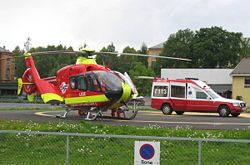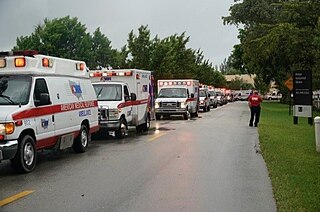
Emergency medical services (EMS), also known as ambulance services or paramedic services, are emergency services that provide urgent pre-hospital treatment and stabilisation for serious illness and injuries and transport to definitive care. They may also be known as a first aid squad, FAST squad, emergency squad, ambulance squad, ambulance corps, life squad or by other initialisms such as EMAS or EMARS.

An emergency medical technician (EMT), also known as an ambulance technician, is a health professional that provides emergency medical services. EMTs are most commonly found working in ambulances. In English-speaking countries, paramedics are a separate profession that has additional educational requirements, qualifications, and scope of practice.
Stiftelsen Norsk Luftambulanse is a Norwegian humanitarian organisation, organised as a non-profit foundation. It primarily promotes and operates helicopter air ambulance services. As of 2014, they operate seven Eurocopter EC135 and one EC145 helicopters out of seven bases in Norway, based on contracts with the state through the Norwegian Air Ambulance. In Denmark, they operate three EC135 out of three bases.

The Norwegian Air Ambulance Service is organised through the government owned limited company Luftambulansetjenesten HF. The service provides helicopter emergency medical service (HEMS) and fixed-wing air ambulance operations.
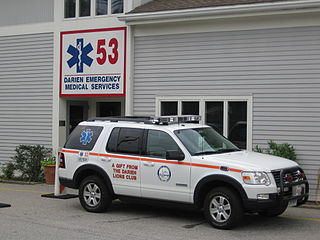
In the United States, emergency medical services (EMS) provide out-of-hospital acute medical care and/or transport to definitive care for those in need. They are regulated at the most basic level by the National Highway Traffic Safety Administration, which sets the minimum standards that all states' EMS providers must meet, and regulated more strictly by individual state governments, which often require higher standards from the services they oversee.

Emergency medical services in Canada are the responsibility of each Canadian province or territory. The services, including both ambulance and paramedic services, may be provided directly by the province, contracted to a private provider, or delegated to local governments, which may in turn create service delivery arrangements with municipal departments, hospitals or private providers. The approach, and the standards, vary considerably between provinces and territories.
Emergency Medical Service in Germany is a service of public pre-hospital emergency healthcare, including ambulance service, provided by individual German cities and counties. It is primarily financed by the German health insurance companies.
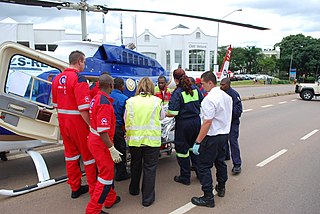
Emergency medical services in South Africa are a public/private system aimed at the provision of emergency ambulance service, including emergency care and transportation to hospital.
Emergency medical services in Italy currently consist primarily of a combination of volunteer organizations providing ambulance service, supplemented by physicians and nurses who perform all advanced life support (ALS) procedures. The emergency telephone number for emergency medical service in Italy is 118. Since 2017 it has also been possible to call by the European emergency number 112, although this is a general police/fire/medical number.
Advanced emergency medical technician (AEMT) is provider of prehospital emergency medical services in the United States. A transition to this level of training from the Emergency Medical Technician-Intermediate (EMT-I), which had somewhat less training, began in 2013 and has been implemented by most states at this point. The AEMT is not intended to deliver definitive medical care in most cases, but rather to augment prehospital critical care and provide rapid on-scene treatment. AEMTs are most usually employed in ambulance services, working in conjunction with EMTs and paramedics, however are also commonly found in fire departments and law enforcement agencies as non-transporting first responders. Ambulances operating at the AEMT level of care are commonplace in rural areas, and occasionally found in larger cities as part of a tiered-response system, but are overall much less common than EMT and Paramedic level ambulances. The AEMT provides a low-cost, high-benefit option to provide advanced-level care when the paramedic level of care is not feasible. The AEMT is authorized to provide limited advanced life support, which is beyond the scope of an EMT.
Emergency medical services in the Netherlands is a system of pre hospital care provided by the government in partnership with private companies.
Ambulance Services in Hong Kong are provided by the Hong Kong Fire Services, in co-operation with two other voluntary organisations, the Auxiliary Medical Service and the Hong Kong St. John Ambulance.
Emergency medical services in Israel are provided by the Magen David Adom (MDA) organization, supplemented by United Hatzalah, and in some places by the Palestinian Red Crescent Society. The phone number to call for an ambulance is 101 and for United Hatzalah is 1221.

Emergency medical services in Poland is a service of public pre-hospital emergency healthcare, including ambulance service, provided by individual Polish cities and counties. These services are typically provided by the local, publicly operated hospital, and funded by the government of Poland. In a number of cases, the hospitals contract these services to private operators. In addition to publicly funded services, there are also a variety of private-for-profit ambulance services operating independently, as well.
Emergency medical services in Iceland include the provision of ambulance service. They provide all emergency ambulance service for a population of in excess of 320,000 people in one of the most sparsely settled countries in Europe. The system is government-funded for the first 85 percent of cost, with 15 percent being charged to the individual as a deterrent fee. All services in Iceland are provided by the Icelandic Red Cross, with individual ambulances often co-located with local fire brigades.

Lørenskog Heliport, Ahus is a heliport situated on the premises of Akershus University Hospital (Ahus) in Lørenskog, Norway. It serves as the main base for air ambulance helicopters in the central part of Eastern Norway. It is a base for a Eurocopter EC-135P2+ and a Eurocopter EC145 T2, both operated by Norsk Luftambulanse (NLA). The base became the first permanent ambulance heliport in the country when it opened in 1978. The facility is owned by Oslo University Hospital.

Stavanger Heliport, University Hospital is a heliport situated on the premises of Stavanger University Hospital in the Våland neighborhood of the city of Stavanger in the municipality of Stavanger in Rogaland county, Norway. Used exclusively for air ambulance services, it is home to a Eurocopter EC-135P2+ operated by Norsk Luftambulanse (NLA) on contract with the National Air Ambulance Service. The base is owned by Stavanger Hospital Trust. When it opened in 1981, it was the second such base in the country.
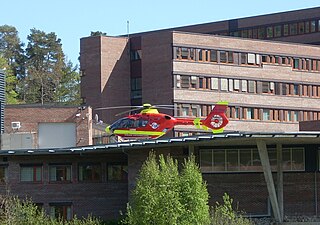
Arendal Heliport, Hospital is a heliport situated on the premises of Arendal Hospital in the Heimdal neighborhood of Arendal, Norway. Used exclusively for air ambulance services, it is home to a Eurocopter EC-135P2+ operated by Norsk Luftambulanse (NLA) on contract with the National Air Ambulance Service. The base is owned by Sørlandet Hospital Trust.

Tromsø Heliport, University Hospital is a heliport situated on the premises of University Hospital of North Norway in the city of Tromsø in Tromsø Municipality in Troms og Finnmark county, Norway. Used exclusively for air ambulance services, it is home to an AgustaWestland AW139 operated by Lufttransport on contract with the National Air Ambulance Service. The base is owned by the University Hospital of North Norway. The base opened in 1988.

Trondheim Heliport, Rosten is a heliport situated in Vestre Rosten in the Tiller neighborhood of Trondheim Norway. Used exclusively for air ambulance missions, it serves as a base for a Eurocopter EC-135P2+ operated by Norsk Luftambulanse (NLA) on contract with the National Air Ambulance Service. The original heliport was situated at Brøset Hospital and opened in 1988. The base moved to Vestre Rosten in the mid 1990s.



